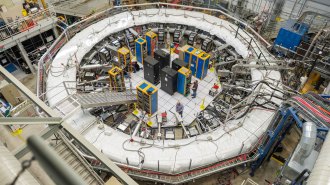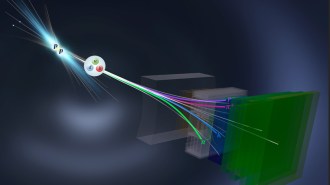Doubt cast on theorized ‘sterile’ particles leaves a neutrino mystery unsolved
A highly reclusive variety of the lightweight subatomic particles seems less likely

The MicroBooNE detector (shown under construction) observes particles produced when neutrinos interact inside. It has found no sign of stealthy particles called sterile neutrinos, despite hints seen in earlier experiments.
Reidar Hahn
- More than 2 years ago
For decades, physicists have suspected an interloper. A reclusive, hypothetical subatomic particle might be creeping into studies of neutrinos, nearly massless particles with no electric charge. A new study casts doubt on that idea, but leaves unsolved the mystery of what caused peculiar results in certain neutrino experiments.
“We still don’t have the answer,” says physicist Kate Scholberg of Duke University, who was not involved with the new result. “It’s simultaneously satisfying and unsatisfying.”
Neutrinos, which come in three known varieties, have shown up in greater numbers than expected in some experiments. That strange behavior raised the tantalizing prospect that a stealthier fourth type of neutrino, called a sterile neutrino, might be awaiting discovery. But new data from the Micro Booster Neutrino Experiment, or MicroBooNE, favor the canonical neutrino trio.
An earlier experiment called MiniBooNE, located at Fermilab in Batavia, Ill., had for years found more neutrinos than expected at low energies, a hint strengthened with more data in 2018 (SN: 6/1/18). An even earlier neutrino experiment, performed in the 1990s, had also seen a similar signal.
With MiniBooNE, scientists studied a phenomenon called neutrino oscillation. The three known varieties of neutrinos — electron neutrinos, muon neutrinos and tau neutrinos — can transform, or oscillate, from one type to another as they travel. MiniBooNE looked for electron neutrinos produced when muon neutrinos oscillated.The apparent glut of electron neutrinos seen by MiniBooNE could indicate that the switch seemed to happen more often than expected, potentially due to sterile neutrinos muddling up the oscillations.
But there was a catch. Particle detectors can’t directly spot neutrinos, instead identifying them by observing other particles spit out when neutrinos interact within a detector. And MiniBooNE tended to confuse electrons — a signature of electron neutrinos — with photons, particles of light that could indicate another particle. That left scientists unsure whether the excess events were really electron neutrinos. The sterile neutrino remained a question mark.
Enter MicroBooNE. Also at Fermilab, the experiment uses an advanced type of detector that can tell electrons from photons. So scientists set out to investigate the excess events — aiming to find out whether they involved electrons or photons. But MicroBooNE, confusingly, found no excess at all. In an October 1 seminar and a paper posted at arXiv.org, MicroBooNE had mostly eliminated the possibility of extra events involving photons. The new result, reported October 27 during a virtual seminar, rules out many of the possible types of extra events involving electrons, making the sterile neutrino idea less plausible.
It’s not clear why one experiment saw an excess while the other didn’t. The difference between the two measurements might come down to the different materials used in the detectors, Scholberg says — carbon in the case of MiniBooNE, argon for MicroBooNE.
Other possible explanations for the excess events that MiniBooNE found remain to be investigated, some of which might go beyond standard physics. The detections, for example, might involve electrons paired with their antimatter partners, positrons. That pair could point the finger at different hypothetical subatomic stuff, in particular, what’s called an axionlike particle.
The researchers “have eliminated a lot of possibilities of what this excess could be, so I found the results pretty compelling,” says physicist Mayly Sanchez of Iowa State University in Ames, who was not involved with the study. “You’re giving fewer and fewer places to hide to these sterile neutrinos.”
But all hope for sterile neutrinos is not lost: A more complicated scenario involving a sterile neutrino combined with other theorized new phenomena could still explain the excess events.
“There’s still a mystery afoot,” says physicist Bonnie Fleming of Yale University, a cospokesperson of the MicroBooNE experiment. “We have more work to do. There’s no doubt about that.”







